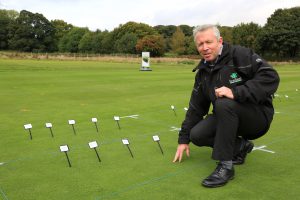How will you now manage microdochium nivale?
Related Articles
Ongoing and future management of the pathogen microdochium nivale was one of the hot topics that greenkeepers discussed at the recent STRI annual ‘Trial Event’, held in Bingley, Yorkshire. Having actively researched and trialled products to suppress the disease for over 10 years, Headland Amenity and Bayer were two of the leading contributors on the topic. David Howells, Headland’s northern area manager, reports on their findings.
“Historically, iprodione-based products have been the main approach to deal with microdochium nivale, applied curatively, when the first stages of the disease are seen. Whilst at the time of writing, fungicide products containing iprodione are still available to use, it has been announced that its withdrawal is now imminent and we will soon be without this valuable tool to control turf disease. So what alternatives are there?

“With climate and legislation changes, preventative disease management will have to be the way forward. Headland Amenity predicted these issues many years ago and has over 10 years of independent trialwork to support effective, alternative preventative strategies, incorporating both fungicides and non-fungicidal products,” he said.
“STRI trials and feedback from turf managers have long shown the beneficial effects of using Headland’s 20-20-30 tank mix to minimise disease levels when applied as part of a preventative programme. This consists of a tank mix of plant hardeners and elicitors, Liquid Turf Hardener, Seamac ProTurf and Turfite. For example, during the autumn of 2016, control trial plots were hit with 75 per cent microdochium nivale disease pressure. Plots treated with 20-20-30 tank mix alone, prior to disease establishment, showed a 50 per cent reduction in this activity.
“As we lose one ‘old chemistry’ active ingredient, a new one, fluopyram, comes to the UK. From a new chemical group of fungicides known as SDHI’s, fluopyram is an acropetal penetrant, which means it can enter the plant through roots, shoots or leaves, and moves up through the plant to provide protective activity. It can be found in Bayer’s new Exteris Stressgard product, alongside trifloxystrobin and the unique ‘Stressgard’ technology which provides plant protection against stress situations resulting in a visibly healthier looking sward. Headland Amenity is a primary supplier of Exteris Stressgard alongside another Bayer product, Dedicate – a systemic fungicide which can be used preventatively at the earliest sign of disease. Alternating applications of these two products assists in reducing any potential resistance risk.
“Moving forwards, whilst iprodione is still on the shelf as a back-up, now is the perfect time to be putting together an integrated strategy combining good cultural practice, managing sward compositions and implementing a preventative fungicidal programme to ensure your facility is prepared for what lies ahead.”

























